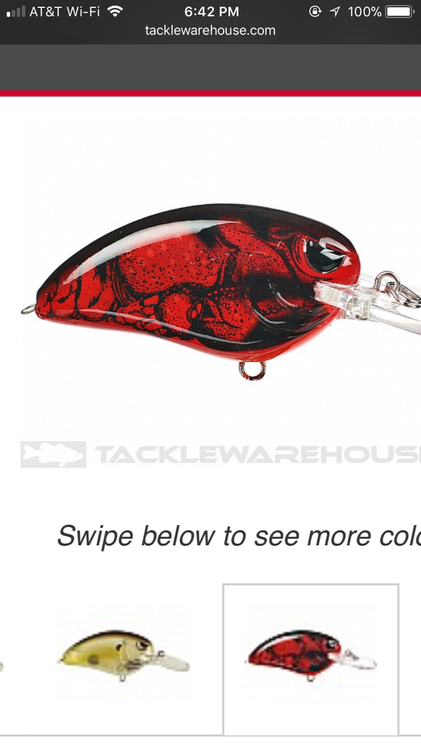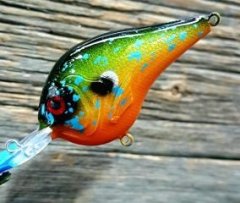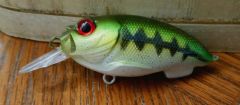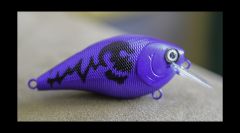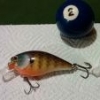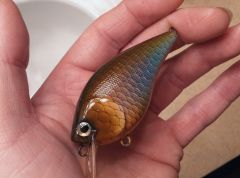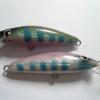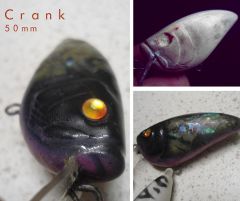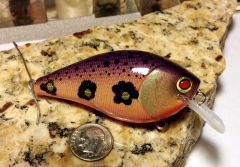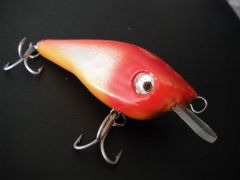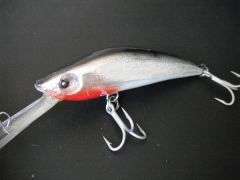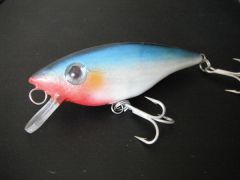Search the Community
Showing results for tags 'crank'.
-
I have done a lot of work on ballast calculators in the past. I have never offered them up for use by TU members because I considered them complicated and clumsy. This one however, I consider to be very slick and versatile. You can enter data from a first prototype and it will calculate how much ballast you need to add or subtract to achieve the buoyancy that you desire, be it slow sink, neutral or float. Boxes 1 and 2 are merely to collect data on the body material in order to obtain the material density. Boxes 3 and 4 are measured from a completed lure with hardware, hooks and topcoat. Box 5 is your desired buoyancy, 100% = neutral buoyancy. Box 6 is the density of the ballast. This can be changed if not using lead. The calculation takes into account the body material removed or added to make room for the ballast. PM your email to me if you would like to try this spreadsheet. Dave
- 55 replies
-
- 6
-

-

-
What is the best way to put weight in a crankbait without a lead pot?
-
Can anyone tell me how companies like Rapala and Spro are making these paint jobs with such crazy detail? Are they using a computer? I have a customer who wants me to duplicate the Spro Fire Craw pattern and it’s crazy detailed! If this is a computerized wrap, how do I get into this?
- 11 replies
-
- crankbait
- custom paint
-
(and 2 more)
Tagged with:
-
I've been painting my own crankbaits using Createx Paint (transparent white as primer coat) and DN-S81 as a clear coat and have noticed that as I'm fishing them and as the finish chips off from hit rocks or whatever that the original color show through. What I mean is the primer coat I put on and all comes off as the finish but the original color does not. How do I solve this? Should I clear coat after I prime the bait? Is there a way to completely remove the original color? Thanks for the help! What a great site.
- 17 replies
-
- custom paint
- paint
-
(and 2 more)
Tagged with:
-
hey guys its been a while sense I've posted here. i am trying to design a new type of crank, at least i don't believe its been made before, i have looked and haven't found anything on the net. anyway, its made from soft plastic. the problem i am having is that i can't get the bait to track straight before it rolls and blows out. a thought came to me last night in bed (when i do my best thinking!!!) that the force and pressure on the lip is probably causing the plastic to actually move, there for changing the angle of attack of the lip, and THAT could be way the bait rolls and blows out. i did see a thread here (sorry i can't remember who posted it or when) of a guy that made a lip that looked more like a half moon, and extended well to the sides. he reported to have good results, but of course that was a hard bait. do any of you MASTERS OF THE CRANK, have any ideas on how i can correct this problem? the original design is for thrusher shark fishing. however my test baits are smaller. also my lip building skills are not, well, great! i've only made two! so i also think that those could be a big problem as well. my lips don't come out perfectly symmetrical . although i can work on that. any help you guys can provide or insights would be great!
-
-
Just a 3" crank I was messing around with trying to get a nice tucked under scale effect. Should've paid more attention to color scheme but the bass around here tend to like brown. Hopefully with alot of practice I can duplicate it on a perch or gill pattern. Createx paint and cement sealer top coat.
© Reelentless
-
-
These are my thoughts, opinions and ideas on hunting lures, after six years of investigation and building hunters. All open for discussion, you can disagree and add your own ideas. If you don’t want to read the technical stuff, you can skip to the last paragraph, but don’t whinge about it, there are people who do like to read this stuff. What is hunting – a regular or irregular stepping away from the line of retrieval. The lure zigzags but the lure always returns to center and the retrieval is still basically a straight line. What is so good about hunting – I believe that it is change of direction that triggers the bite. How many times have we seen fish trail the lure all the way back to the rod tip, obviously interested, but not biting. When a fish changes direction, it cannot immediately change again. So immediately after a change in direction would be a good time to attack. I believe that the trailing predator is simply instinctively waiting for that change of direction. What causes hunting – hunting occurs at transitions. This can be at the edge of stability, just before the lure blows out or at the transition between two different actions. At the transition, the lure tries to do something different but reverts back to normal action. This disturbs the regular action pattern and results in a change of direction. Often hunting is seen on a lure when you increase the retrieval speed. Hunting I find is relative to retrieval speed. To explain this, I have to discuss with you my ideas on swim angle. Static angle – when the lure is static, sitting in the water, its angle is determined by its distribution of weight of the different components that are heavier than water; ballast, hooks, harness, lip, top coat, eyes, rings – all have an effect on the center of gravity (CoG), a single point in the lure that all the downward forces are acting. Then there is the center of flotation (CoF), the single point at which all the lighter than water components are acting, namely the bare body. When the lure is still, the CoG and the CoF are vertically aligned and this determines the angle that the lure sits. If you remove the rear hook, the CoG moves forward a tad, then, when the CoG and CoF vertically align, the angle of the lure becomes steeper. Dynamic angle – when the lure starts moving, everything changes. There are new forces on the lure. The static forces of weight and flotation are still there, but there are additional forces; the water passing the lip and the back of the body. As the speed of the lure increases, so these extra dynamic forces become stronger, to the point of making ballast location quite irrelevant in determining the angle that the lure swims. Don’t get me wrong now, ballast is still very important and controls the action, how the lure wobbles, but has very little effect on the swim angle. The forces on the lip below the tow eye are trying to make the lure swim steeper and the forces above the tow eye, on the back of the lure are trying to make the lure swim flatter. The lure swims at an angle were the two forces are equal. Keeping all else equal, if the body is fatter, the lure will swim flatter, if the lip is extended, the lure will swim steeper and so on. This is why the eye position on deep divers is so critical, there is an optimum swim angle for achieving maximum depth. The eye position controls the ration of lip forces to body forces, basically acting as a fulcrum or balance point. Effect of speed – if the dynamic effect on the lip and the body were the same, then the lure would always swim at the same angle and never blow out. But we all know that speed does have an effect on the lures that we build. The dynamic forces on the sharp edged lip build up faster than on the rounded shape of the back. So, as the lure increases in speed, the lure swims steeper in order to balance the two dynamic forces. when the lip reaches vertical, any additional speed will press on the lip and rotate the lure past the vertical. The effective area of the lip will be reduced and the force on the back of the lure will rotate it back again. The lure has now changed action and is porpoising or nodding up and down. The technical term would be pitching. What has this to do with hunting – Like I said earlier, hunting occurs at transitions. Here we have found the pitch/yaw transition. As the lure reaches this transition, the lure will occasionally ‘bob’. This disturbs the wobble action, replacing one of the side movements with a bob and this is what causes the change in direction. As the lure swims away from the line of retrieval, the angle on the inside edge of the lip become steeper. The steeper the edge of the lip, the more force is generated. The lure bobs and direction is changed back towards center. The lure always bobs on the steep side, so the lure always comes back to center. How do I build a hunter – simply build with a lip that is too long and no longer wobbles and has the porpoising action. Trim the lip back until the wobble action just starts and it should hunt. Dave
- 27 replies
-
- 1
-





